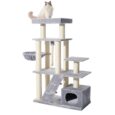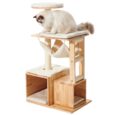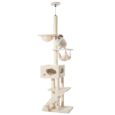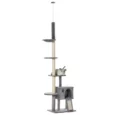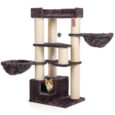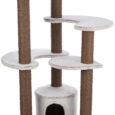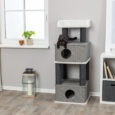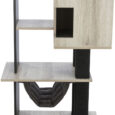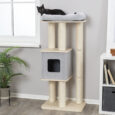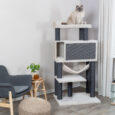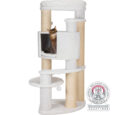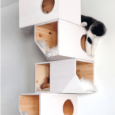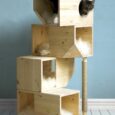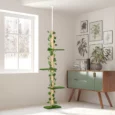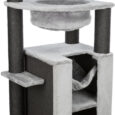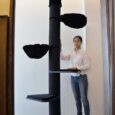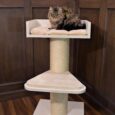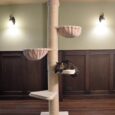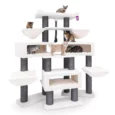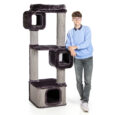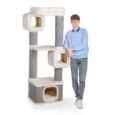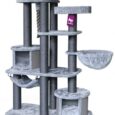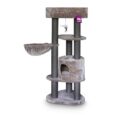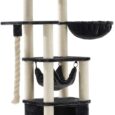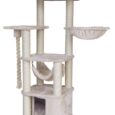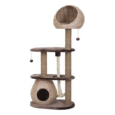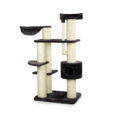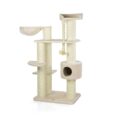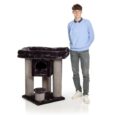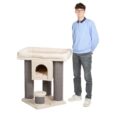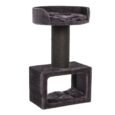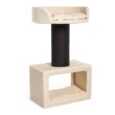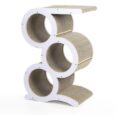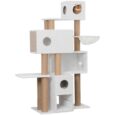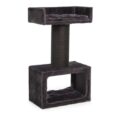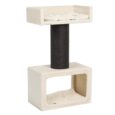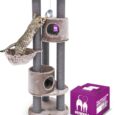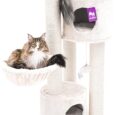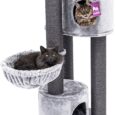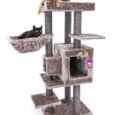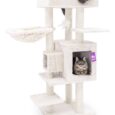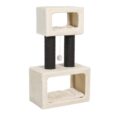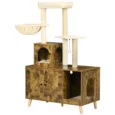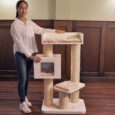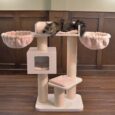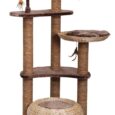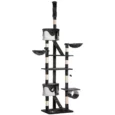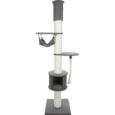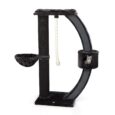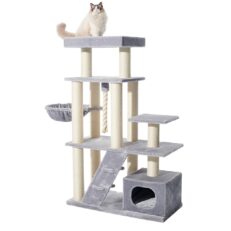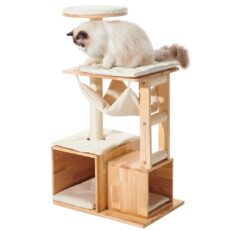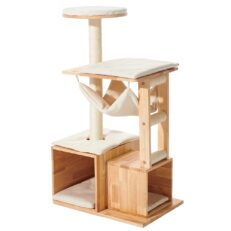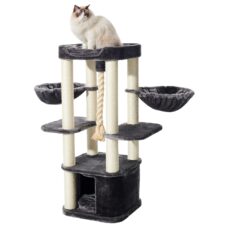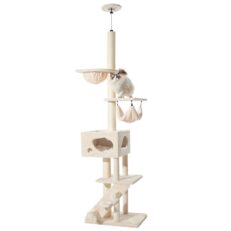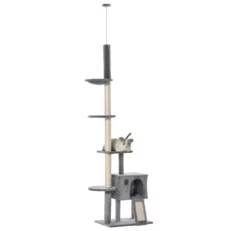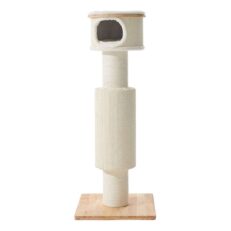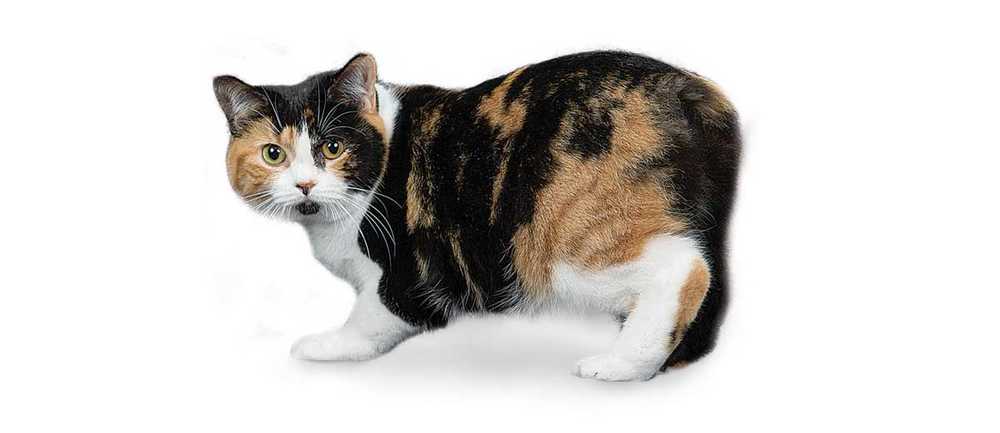
Brief Introduction to the Manx Breed
The Manx cat is a unique and historical breed renowned for its most distinctive feature: taillessness. Originating from the Isle of Man, the breed has a naturally occurring mutation that shortens the tail. Some Manx cats have just a small rise of bone where a tail would normally be (known as “rumpies”), while others may have a short stub (known as “stumpies”).
Beyond their taillessness, Manx cats have a robust build with a rounded appearance. They possess a compact body, broad chest, and a short back with a deep flank. Known for their strong hind legs that are longer than the front, Manx cats have a rabbit-like hop and are capable of powerful jumps. Their coat can come in various colors and patterns, and they are covered with a double layer that can be either short or semi-long.
The Manx is known for its dog-like characteristics, being loyal, friendly, and often willing to play fetch. They are intelligent and enjoy interactive play with their human companions.
Importance of Cat Trees for Indoor Manx Cats
For the Manx, as with any indoor cat, a cat tree is an essential item that supports both their physical and mental health. The robust build of the Manx cat requires regular exercise to prevent weight gain, and a cat tree can provide the opportunity for climbing and stretching, which is critical to maintaining muscle tone and preventing obesity.
Mentally, cat trees offer an outlet for the Manx’s instinctual behaviors like scratching, which is vital for claw health and territory marking. The elevated platforms provide a safe space where they can observe their surroundings, satisfying their need for a high vantage point to survey their environment, which is essential for their mental stimulation and well-being.
Unique Aspects of Cat Trees for Manx Cats
When selecting a cat tree for a Manx, consider their distinctive body structure and jumping capability:
Durability: The cat tree must be sturdy and durable to hold the weight of a robust Manx without tipping over.
Varied Platform Heights: Since Manx cats can jump high, the cat tree should have platforms at various levels to challenge them and allow for natural climbing behavior.
Large Bases and Platforms: Manx cats might have a broader girth, so larger bases and platforms are necessary to accommodate their size comfortably.
Ramp or Step Features: Due to their unique hindquarters and hopping gait, some Manx cats may appreciate a cat tree with ramps or steps, making it easier to navigate between levels.
Secure Scratching Posts: A robust scratching post is crucial for their powerful hind legs, so ensure that the scratching areas are stable and made of durable materials like sisal.
Quality Material: A soft yet resilient material will cater to the comfort of the Manx without wearing down quickly from their robust activities.
Interactive Elements: The playful nature of the Manx can be engaged with hanging toys, ropes, or branches to swat and climb, stimulating their hunting instincts and providing a form of exercise.
Incorporating these features will make a cat tree an ideal investment for the well-being of a Manx cat, ensuring it provides a source of physical activity, mental stimulation, and a place of rest.
I. The Manx Cat: A Quick Breed Profile
A. Historical Background and Physical Characteristics of Manx Cats
Historical Background:
- The Manx cat is native to the Isle of Man in the Irish Sea, where it has been present for centuries. The breed is most famous for its genetic mutation that leads to a tailless or short-tailed appearance, known as “rumpy” and “stumpy,” respectively.
- The taillessness is attributed to a dominant gene, and the length can vary from no tail at all to a normal-length tail.
- Folklore abounds with tales about the breed, including myths that they were last to board Noah’s Ark and had their tail slammed in the door.
Physical Characteristics:
- Tail Variations: Beyond “rumpy” and “stumpy,” there are “rumpy risers” with a small bump of tail, and “longies,” which have a more typical tail length.
- Body: Manx cats have a robust and rounded appearance, with a broad chest and a short back that arches from the shoulders to the rounded rump.
- Legs and Feet: Their hind legs are longer than their front legs, which gives them a distinctive hop-like gait. The feet are usually round and firm.
- Head and Ears: They have a round head with prominent cheeks, large round eyes, and medium-sized ears that are wide at the base.
- Coat: The Manx has a double coat that can come in various colors and patterns. The coat is dense and plush, adding to their rounded appearance.
B. Understanding the Manx Cat’s Distinct Behaviors and Traits
Distinct Behaviors and Traits:
- Affectionate and Loyal: Manx cats are known for their affectionate nature, often forming strong bonds with their families. They can be quite loyal and follow their owners from room to room.
- Playful and Hunter-like: They retain a playful, kitten-like demeanor into adulthood and are skilled hunters.
- Intelligent and Trainable: Manx cats are intelligent and can be trained to perform simple commands and tricks. They are also known for their ability to problem solve, such as opening doors or escaping enclosures.
- Dog-like Characteristics: They are sometimes compared to dogs in their loyalty and willingness to come when called, and some enjoy games of fetch.
- Vocalization: While not overly talkative, Manx cats will communicate with their owners with a soft trill or meow when necessary.
C. Special Health Considerations for Manx Cats
Health Considerations:
- Manx Syndrome: A collection of birth defects often associated with the gene that causes taillessness, including spina bifida, which can affect the spine and sometimes the bowels and bladder function.
- Arthritis: Tailless Manx cats may develop arthritis in the spine or back end, particularly if there are bone remnants where the tail would have been.
- Sensitivity to Anesthesia: As with many purebreds, Manx cats can have a sensitivity to anesthesia, so this should be discussed with a veterinarian prior to surgical procedures.
It is recommended for potential Manx owners to work with reputable breeders who conduct health screenings. Regular veterinary check-ups are crucial to monitor and manage any health issues early on. With the right care and attention, Manx cats make delightful and engaging companions well-suited for various households.
Cat trees play a crucial role in the well-being and daily life of a Manx cat for several reasons:
A. Why climbing and scratching are essential activities: Climbing and scratching are fundamental feline behaviors that cater to a cat’s physical and psychological needs. For the Manx cat, climbing allows it to explore its environment and satisfy its instinctual drive to survey its territory from high vantage points. Scratching is important for maintaining claw health, marking territory through scent glands in the paws, and stretching muscles. A cat tree provides an outlet for these natural behaviors, keeping the Manx both mentally and physically stimulated.
B. The Manx’s need for exercise to prevent weight gain: The Manx breed can be predisposed to weight gain due to their body structure, which can lead to obesity-related health issues. Regular exercise is crucial for maintaining a healthy weight. A cat tree encourages physical activity through climbing, jumping, and playing, which can help to manage the cat’s weight. Furthermore, engaging toys attached to the tree can stimulate play, which is an excellent form of exercise.
C. How cat trees can help with Manx-specific mobility issues: The Manx breed is known for its unique taillessness, with a genetic mutation that can sometimes affect spinal and hip formation. This can lead to mobility issues in some Manx cats. Cat trees with strategically placed platforms and supportive cushions can cater to these special needs by allowing the cat to climb without overexerting itself. Features like graduated platforms or ramps can aid in their mobility, and lower perches can provide easy-to-reach resting spots. Moreover, a well-designed cat tree can help prevent jumping from too high places, protecting the Manx from potential injuries due to their unique anatomy.
Overall, for Manx cats, a cat tree is not just a piece of play equipment; it’s a multipurpose tool that promotes a healthy lifestyle. It should be sturdy and well-balanced to support their sometimes more robust bodies and designed with their physical capabilities and limitations in mind.
Manx cats are a unique breed, best known for their taillessness, although some Manx cats do have a short tail. Their rear legs are longer than their front, giving them a distinctive rounded appearance and a powerful jump. When selecting a cat tree for a Manx, it’s important to consider their physical characteristics and behavior tendencies. Here’s a tailored approach:
A. Stability and Durability: A Must for a Solidly Built Cat
Key Feature: A cat tree with a heavy, wide base and solid construction that can support the weight and force of a jumping Manx.
Importance: Manx cats are muscular and solidly built, so they need a cat tree that won’t wobble or tip during their energetic play.
B. Easy Access: Suitable for Cats with Short or Missing Tails
Key Feature: Ramps or steps for easy access, and platforms with a gradual increase in height.
Importance: Although Manx cats can jump well, those with shorter tails might have balance issues. Easier access to various levels will accommodate any potential limitations.
C. Comfort Features: Soft Bedding and Rounded Edges
Key Feature: Ample cushioning on the platforms and edges that are rounded or padded to prevent injury.
Importance: Comfort is key for all cats, including the Manx. Soft bedding will be inviting for rest, and rounded edges will protect the Manx cat, which may have less balance due to the lack of a tail.
D. Height and Layout: Suitable for the Manx’s Jumping Capabilities
Key Feature: Various levels that allow the Manx to jump and climb comfortably.
Importance: Despite any balance issues, many Manx cats enjoy leaping. Providing different heights will cater to their instinctual need to climb and survey their environment.
E. Materials and Textures: Catering to the Manx’s Scratching Preferences
Key Feature: A combination of scratching surfaces, such as sisal rope, jute, or corrugated cardboard.
Importance: Scratching is a natural behavior for all cats, including the Manx. Offering a variety of textures can keep the cat tree interesting and appealing for scratching, which in turn, helps to keep their claws healthy.
In conclusion, when looking for the perfect cat tree for a Manx cat, focus on stability and durability to support their robust build, provide easy access to accommodate potential balance issues, ensure comfort with soft materials and rounded edges, allow for their natural jumping behavior with a variety of heights, and cater to their scratching preferences with multiple textures. Taking these factors into account will help ensure the cat tree is a safe, enjoyable, and frequently used investment for your Manx cat’s daily activities.
A. Best Practices for Cleaning and Maintaining Cat Trees
Maintaining the cleanliness and integrity of a cat tree is essential for the health and safety of your Manx. Here’s how to keep it in top condition:
- Vacuum Regularly: Use an upholstery attachment to remove fur and dander from the platforms and scratching posts.
- Spot Cleaning: Address spills or accidents immediately with a mild, pet-safe detergent and water.
- Deodorizing: Sprinkle baking soda on the cat tree and let it sit before vacuuming to help neutralize odors.
- Inspect for Loose Parts: Check the cat tree for any loose nails, screws, or staples that could injure your cat.
- Tighten Fittings: Periodically tighten all the screws and bolts to ensure the tree remains stable.
- Replace Worn Parts: Scratching posts wrapped in sisal can be rewrapped or replaced when they get too frayed.
- Washable Covers: If your cat tree has removable fabric covers or pads, wash them according to the manufacturer’s instructions.
B. Recognizing Wear and Tear Specific to the Manx’s Use
The Manx’s robust body and strong hindquarters may lead to specific patterns of wear:
- Base Stability: The power of a Manx’s jump can loosen the base over time. Check for any wobbling or instability.
- Scratching Posts: These cats may favor certain posts, leading to uneven wear. Rotate the tree if possible to distribute use.
- Platform Edges: The heavier build of a Manx may lead to quicker wear around the edges of platforms where they jump up or settle down.
- Jumping Areas: Areas used for jumping on or off the cat tree may show signs of stress or damage sooner due to the powerful jumps typical of the breed.
C. When to Replace or Update Components of the Cat Tree
Be mindful of the following indicators that parts of the cat tree require updating or replacing:
- Visible Damage: Any visible break or damage to the cat tree’s structure is a clear sign it needs repairing or replacing.
- Wobbly Components: If any part of the tree has become unstable and can’t be tightened or repaired, it’s time to replace that section.
- Bare Scratching Posts: Once the scratching posts are stripped of their material and the underlying structure is exposed, they should be rewrapped or replaced.
- Irreparable Wear: Prolonged use can lead to wear that is beyond simple fixes, indicating the need for new parts or a new tree.
- Safety Concerns: Above all, the safety of your cat is paramount. Any safety concern warrants an immediate replacement to prevent injury.
Keeping a close eye on the cat tree’s condition and ensuring it is clean and in good repair will help to prolong its life and provide a safe, enjoyable space for your Manx to play, scratch, and relax.

